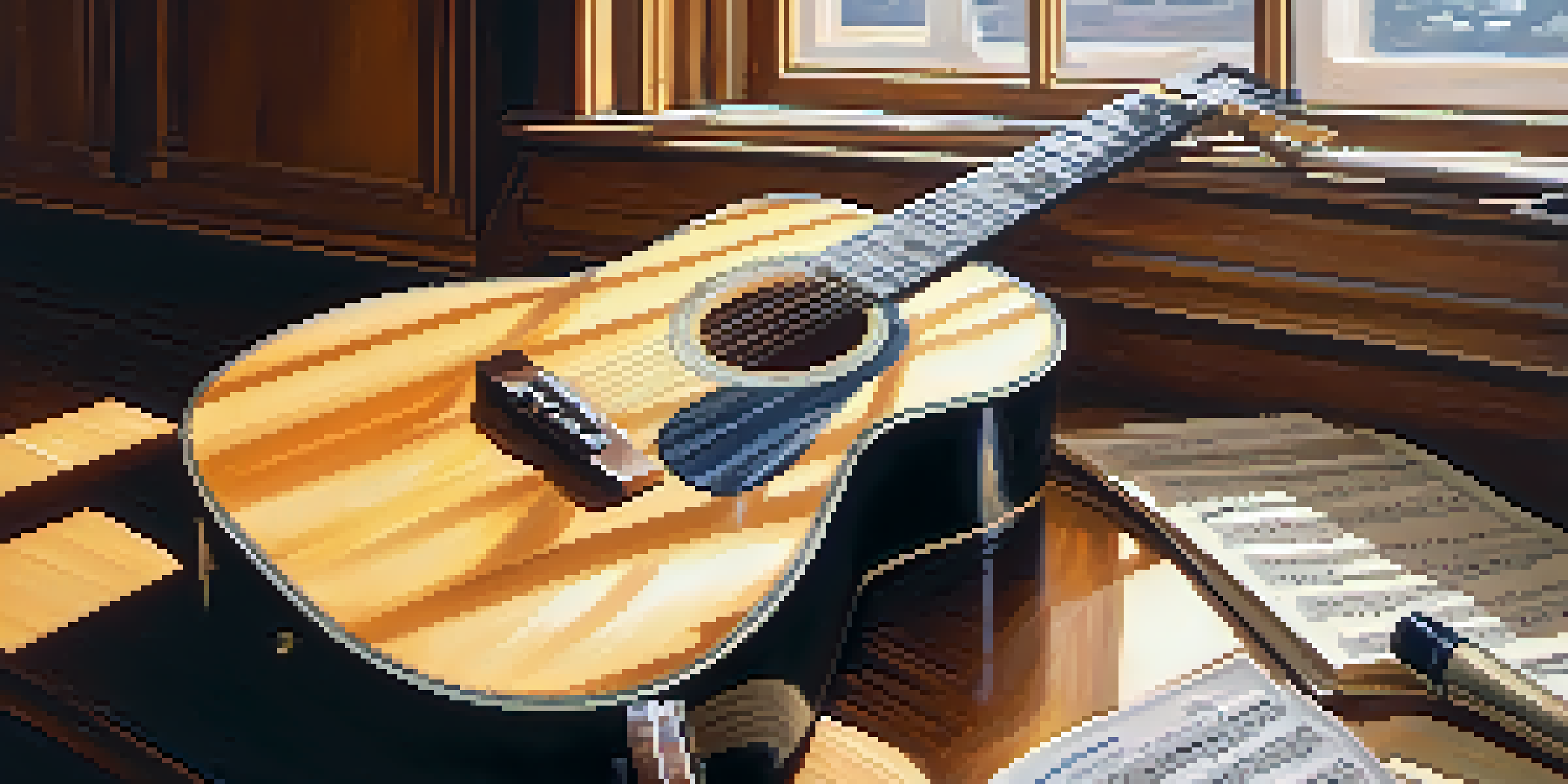The Role of Rhythm in Guitar Music Composition Techniques

Understanding Rhythm and Its Importance in Music
Rhythm is the heartbeat of music, providing structure and flow. It’s what makes you tap your foot or sway to the beat. In guitar composition, rhythm sets the foundation upon which melodies and harmonies are built, making it essential for creating engaging pieces.
Rhythm is the soul of music, and without it, there can be no melody.
Think of rhythm as the framework of a house; without it, the entire structure collapses. Just as you wouldn’t build a house without a solid foundation, a guitarist must understand rhythm to craft compelling music. It gives context to notes, transforming simple melodies into memorable tunes.
Moreover, rhythm brings energy and emotion to a composition. It can evoke feelings of excitement, melancholy, or tension, depending on how it’s employed. Recognizing the role of rhythm is the first step in mastering guitar music composition.
Basic Rhythmic Patterns Every Guitarist Should Know
There are several fundamental rhythmic patterns that serve as building blocks for guitar music. For instance, the simple quarter note pattern is a staple, providing a steady pulse that is easy to follow. This pattern can be combined with eighth notes and rests to create more complex rhythms.

A great way to practice these patterns is to play along with a metronome or backing track. This not only helps you stay in time but also allows you to experiment with different feels. Incorporating variations, like syncopation, can add an exciting twist to your playing.
Rhythm is Music's Foundation
Understanding and mastering rhythm is essential for creating engaging and memorable guitar compositions.
By mastering these basic patterns, guitarists can enhance their compositions significantly. It’s like learning the basic strokes of painting before creating a masterpiece; each pattern opens up new possibilities for creativity.
The Power of Syncopation in Guitar Music
Syncopation can transform a straightforward rhythm into something captivating. It involves placing emphasis on unexpected beats, creating a sense of surprise and excitement. This technique can make your guitar pieces more dynamic and interesting.
Music is the shorthand of emotion.
For example, consider a simple four-beat measure where you emphasize the off-beats. This subtle shift can make a familiar melody feel fresh and engaging. Many famous guitarists, like Jimi Hendrix, used syncopation to create their signature sounds.
Incorporating syncopation into your compositions can take practice, but the payoff is worth it. It allows you to break free from predictable patterns and explore new rhythmic landscapes.
Using Polyrhythms to Enrich Guitar Composition
Polyrhythms involve playing two or more contrasting rhythms simultaneously, adding depth and complexity to your music. This technique can be especially effective in genres like jazz and world music, where intricate rhythms are celebrated. By experimenting with polyrhythms, guitarists can create a rich tapestry of sound.
Start by layering a simple rhythm on top of a more complex one. For example, you might play a steady eighth-note pattern while adding triplets over it. The contrasting rhythms will create a beautiful interplay that captivates listeners.
Explore Syncopation for Excitement
Incorporating syncopation can add surprise and dynamic interest to your guitar pieces.
While polyrhythms can be challenging to master, they offer a unique way to express creativity. They push the boundaries of traditional guitar composition and invite you to explore new rhythmic territories.
Incorporating Dynamics and Tempo Changes
Dynamics and tempo changes can drastically alter the feel of a piece. By varying the volume (dynamics) and speed (tempo), you can highlight specific sections of your composition, making them stand out. This adds a layer of emotional depth, allowing you to guide the listener’s journey.
For example, starting a piece softly and gradually increasing the volume can create tension and anticipation. Conversely, sudden tempo changes can inject excitement and surprise. These techniques help maintain interest, keeping the audience engaged.
Incorporating dynamics and tempo changes into your compositions may take some experimentation. However, when done effectively, they can elevate your music from ordinary to extraordinary.
The Role of Rhythm in Improvisation on Guitar
Improvisation is an essential skill for guitarists, and rhythm plays a crucial role in this practice. When improvising, having a strong grasp of rhythm allows you to express yourself more freely and creatively. You can explore different rhythmic patterns, making your solos more vibrant and engaging.
Imagine a jazz guitarist improvising over a swing rhythm; the way they manipulate time creates a unique musical conversation. They might play behind the beat for a laid-back feel or ahead of the beat for a more aggressive sound. This rhythmic flexibility is what makes improvisation exciting.
Practice Improves Rhythmic Skills
Regular practice through clapping, backing tracks, and exploring new styles enhances your rhythmic understanding and guitar performance.
Practicing improvisation with a focus on rhythm can help you develop your unique voice as a guitarist. It encourages experimentation, leading to unexpected and delightful musical moments.
Combining Rhythm with Melody and Harmony
While rhythm is essential, it works in harmony with melody and harmony to create a complete composition. Understanding how these elements interact can enhance your songwriting process. For example, a catchy melody paired with an interesting rhythmic pattern can create a memorable hook.
Conversely, a strong rhythmic foundation can give a melody the support it needs to shine. By experimenting with different rhythmic approaches, you can discover new ways to express your musical ideas. This interplay between rhythm and melody is what often makes a song resonate with listeners.

Ultimately, combining these elements allows for richer and more varied compositions. Embracing the relationship between rhythm, melody, and harmony can elevate your guitar music to new heights.
Practical Exercises to Improve Rhythmic Skills
Improving your rhythmic skills takes practice, but there are several effective exercises you can try. Start by clapping or tapping out rhythms before playing them on your guitar. This can help solidify your understanding of timing and pattern recognition.
Another great exercise is to play along with drumming patterns or backing tracks. This not only helps you stay in time but also allows you to experiment with different rhythmic feels. Recording yourself while practicing can also provide valuable insights into your timing and rhythm.
Finally, don’t forget to challenge yourself with new styles and genres. Each musical style has its unique rhythmic characteristics, and exploring these can broaden your understanding of rhythm in guitar composition. Remember, the more you practice, the more natural rhythm will become in your playing.